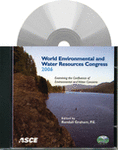Geomorphic Meander Restoration of Incised and Aggraded Systems in the Blue Mountain Range in Washington State
Publication: World Environmental and Water Resource Congress 2006: Examining the Confluence of Environmental and Water Concerns
Abstract
The 325-square mile Asotin Creek Watershed is located in the Blue Mountain Range in Washington State. Asotin Creek is one of several Model Salmon Recovery Watersheds designated by the Northwest Power Planning Council. In January 1997, two large floods caused extensive stream damage. The streamflow magnitude exceeded a 40-year return period flood that was 10 times greater than the bankfull discharge. Prior to the flood, Asotin Creek was an unstable, high width/depth ratio channel caused by a long history of poor land use practices. Previously constructed dikes in some locations breached during the flood. Poor riparian vegetation and associated unstable banks caused the stream to convert from a single or dual-thread channel to a multiple-thread braided channel following the flood. The South Fork tributary to Asotin Creek had incised during the 1997 flood event. Both reaches contained potential steelhead habitat due to their proximity to the Snake River. Existing post-flood habitat was degraded due to bank instability, high sediment supply, elevated water temperatures, poor spawning habitat and the lack of both overhead and in-stream cover. During the summers of 1997 and 1998, two natural channel meander reconstructions were completed on the braided reach (Koch Project) and on the incised reach (J-Bar Ranch), both in the same watershed. A geomorphic approach using a combination of dimensionless ratios, empirical relationships, and bedload competence equations related to a specific reference stream type were used as a basis for the designs. Since 1997 and 1998, each restoration project has been monitored for response. Both sites have been subjected to several floods exceeding five times the bankfull stage. Even though both streams are in high bedload watershed conditions, the restored reaches have not only maintained their stability, but also substantially improved the anadromous salmonid population, riparian vegetation, root cohesion, and floodplain development. In both cases, a stable plan-form, dimension, and profile have been maintained since the restoration projects were completed. Local deposition and scour have been achieved with riparian cover and woody debris without aggradation or degradation. In-stream structures were integrated as a component of the geomorphic design as opposed to pre-selecting structures to stabilize the post-flood channel. Reconstructing a stable channel dimension, pattern and profile following geomorphic processes met the multiple objectives of the restoration, yet accommodated subsequent large floods. The restoration monitoring provided evidence to document the success of the restoration.
Get full access to this chapter
View all available purchase options and get full access to this chapter.
Information & Authors
Information
Published In
Copyright
© 2006 American Society of Civil Engineers.
History
Published online: Apr 26, 2012
ASCE Technical Topics:
- Channels (waterway)
- Design (by type)
- Ecological restoration
- Ecosystems
- Engineering fundamentals
- Environmental engineering
- Floods
- Geology
- Geomorphology
- Geotechnical engineering
- Hydraulic design
- Hydraulic engineering
- Hydraulic structures
- Mountains
- River engineering
- River systems
- Rivers and streams
- Vegetation
- Water and water resources
- Watersheds
- Waterways
Authors
Metrics & Citations
Metrics
Citations
Download citation
If you have the appropriate software installed, you can download article citation data to the citation manager of your choice. Simply select your manager software from the list below and click Download.
